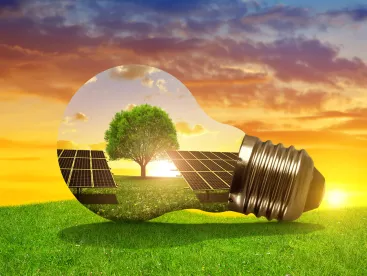Summary
As of February 9, 2018, the Bipartisan Budget Act of 2018 retroactively extended many energy related credits that expired December 31, 2016. The Act extended the investment tax credit under Code §48 through 2022 (with phaseouts for some) for certain solar fiber-optic, thermal energy, fuel cell, small wind, microturbine, and combined heat and power projects, similar to the already extended ITC for solar. These technologies had been left out of the 2015 legislation that extended the ITC for solar and wind with various phasedowns.
In Depth
Many energy related credits expired December 31, 2016. The Bipartisan Budget Act of 2018 (Act), signed into law on February 9, 2018, extended many of these credits retroactively for one year to December, 31, 2017. The Act also extended the investment tax credit (ITC) under Code §48 through 2022 (with phaseouts) for certain solar fiber-optic, thermal energy, fuel cell, small wind, microturbine, and combined heat and power projects, similar to the already extended ITC for solar. These technologies had been left out of the 2015 legislation that extended the ITC for solar and wind with various phasedowns. The Act also eliminated the sunset deadline under Code §45J for certain nuclear facilities.
Investment Tax Credit Extensions
The Act generally extended the ITC for certain technologies, other than solar which had already been extended until 2022, with various phaseouts applying after 2020. Equipment that uses solar energy to illuminate the inside of a structure using fiber-optic distributed sunlight and equipment which uses the ground or ground water as a thermal energy source to heat a structure or as a thermal energy sink to cool a structure now qualify for the ITC if construction begins prior to January 1, 2022. The ITC for qualified fuel cell, qualified small wind, microturbine, combined heat and power was also extended to qualifying projects beginning construction prior to January 1, 2022. Qualifying fuel cell, qualified wind and fiber-optic solar, are subject to a phaseout that is similar to the current phaseout applying to solar projects. If construction begins on qualifying fuel cell, small wind or fiber-optic solar property after December 31, 2019, and before January 1, 2021, the ITC is phased down from 30 percent of qualifying costs to 26 percent. If construction on such property begins after December 31, 2020, and before January 1, 2022, the ITC is 22 percent of qualifying costs. A special rule provides that if any qualifying fuel cell, small wind or fiber-optic solar property is not placed in service before January 1, 2024, the ITC is zero. For microturbine and combined heat and power projects, no phaseout rules appear to apply. An effective date rule provides that, in the case of all of these types of projects other than combined heat and power projects, eligible basis for purposes of the ITC includes only basis attributable to construction and acquisition costs incurred after December 31, 2016. With respect to combined heat and power projects, these new rules apply to such projects placed in service after December 31, 2016.
In addition, the election to take the investment tax credit in lieu of the production tax credit was extended accordingly.
Extension of Credit for Residential Energy Property
The Act extended the Code §25D tax credit for all relevant renewable technologies (fuel cells, small wind and geothermal heat pump) placed in service through December 31, 2021. This amendment puts these other technologies on equal footing with solar electric and solar water heating technologies, which had previously received the same extension under this credit in 2015. The credit is subject to a phasedown for all technologies beginning in 2020.
Nuclear Production Tax Credits Available for Facilities Placed in Service after 2020
Code §45J provides a production tax credit equal to 1.8 cents per kilowatt-hour of electricity produced for the eight year period starting when a qualifying advanced nuclear power facility is placed in service. An “advanced nuclear power facility” is any nuclear facility for which the reactor design is approved by the Nuclear Regulatory Commission after 1993, and the facility is placed in service before January 1, 2021. Currently, only three power plants have qualified for the Code §45J credits, but due to delays and other factors, none of these qualifying plants are expected to be completed and placed in service before January 1, 2021.
The Act allows unutilized Code §45J nuclear production tax credits to be allocated to qualifying nuclear facilities that are placed in service after December 31, 2020. The unutilized credits would be allocated first to qualifying facilities placed in service before January 1, 2021, and then to qualifying facilities placed in service after January 1, 2021. Elimination of the sunset provision allows credits to be used for qualifying facilities that are completed and placed in service after January 1, 2021.
The Act also allows certain public entities to forego their nuclear credits in favor of eligible project partners. Qualified public entities would include (i) governmental entities (including any political subdivision, agency or instrumentality thereof); (ii) mutual or cooperative electric companies; or (iii) not-for-profit electric utilities which have or had received a loan or loan guarantee under the Rural Electrification Act of 1936. An eligible project partner would include any person who designed or constructed the power plant, participates in the provision of nuclear steam or nuclear fuel to the plant, or has an ownership interest in the facility.
The Act did not expand the definition of advanced nuclear power facility to include older plants. Thus, Code §45J, as amended, will continue to apply only to newly designed and constructed nuclear power plants.
Energy Related Credits and Incentives Extended through December 31, 2017
- Code §25C, which provides a tax credit for energy efficiency improvements in the building envelope of existing homes and for the purchase of high-efficiency heating, cooling and water-heating equipment, for improvements and property placed in service in 2017
- Code §30B, which provides a tax credit for new qualified fuel cell motor vehicles, for such vehicles purchased before the end of 2017
- Code §30C, which provides a tax credit for alternative fuel vehicle refueling property, for such property placed in service in 2017
- Code §30D, which provides a tax credit for plug-in electric vehicles, but only for 2-wheeled plug-in vehicles that were acquired before December 31, 2017
- Code §40, which provides a credit for certain alternative fuels, but only for qualified second generation biofuel producers
- Code §40A, which provides a credit for biodiesel and renewable energy used as fuel, for fuel sold or used through December 31, 2017; corresponding extensions were provided for the excise tax provisions applicable to these fuels, as well as special 2017 procedures for biodiesel mixture credits
- Code §45, the production tax credit, with respect to Indian coal facilities, which received a one year extension on their ten year credit period
- Code §45, the production tax credit, with respect to the following technologies:
- Closed-loop biomass facilities, with respect to which construction began before January 1, 2018 and certain co-fired closed-loop biomass facilities placed in service before such date;
- Open-loop biomass facilities, with respect to which construction began before January 1, 2018;
- Geothermal facilities, with respect to which construction began before January 1, 2018;
- Landfill gas facilities, with respect to which construction began before January 1, 2018;
- Trash facilities, with respect to which construction began before January 1, 2018;
- Hydropower facilities, with respect to which construction began before January 1, 2018 or which is placed in service before such date, in the case of incremental hydropower; and
- Marine and hydrokinetic renewable facilities, with respect to which construction began before January 1, 2018.
- Code §45L, a credit for energy efficient homes
- Code §168(l), which provides a special allowance for second generation biofuel plant property, if placed in service before January 1, 2018
- Code §179D deduction for energy efficient commercial buildings, if placed in service before January, 2018
- Code §451 special rule for qualified utilities for sales or dispositions to implement Federal Energy Regulatory Commission or State electric restructuring policy
- Code §§6426 and 6427, which provide excise tax credits for alternative fuels, with respect to fuel sold before January 1, 2018
- Code §4611, which provides a special financing rate for Oil Spill Liability Trust Funds






 />i
/>i


